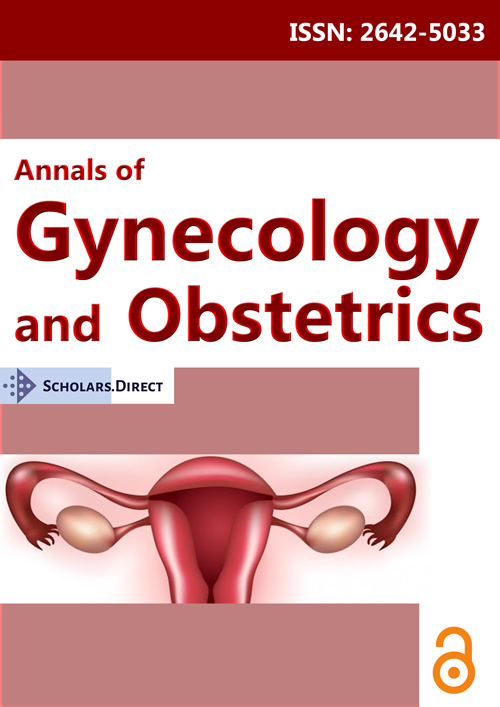Case Report: A Rare Presentation of Imperforate Hymen
Abstract
Imperforate hymen is relatively rare, but it is the most common obstructive abnormality of the female lower genital tract. The clinical presentation varies considerably from patient to patient depending on the age at which the diagnosis is made, but in most cases the diagnosis is missed in early childhood. Therefore, the diagnosis is made after puberty when the patient has hematocolpos, hematoma or both. When this happens, the presentation may be tactical as the patient may have symptoms such as urinary retention or intestinal cryptomenorrhea.
In this case we reported a 13 years old adolescent with imperforate hymen and presented with history of lower abdominal pain and distension associated with difficulty in passing of urine. She was treated by hymenotomy and improved before discharged home. This case report presents the possibility that hematocolposed hymen may be used as a differential diagnosis in adolescent girls, especially those who have not yet reached puberty and may have severe urinary retention, so as to eliminate the possibility of imperforate hymen, as a cause of acute urinary retention due to haematocolpos.
Keywords
Imperforate hymen, Urinary retention, Haematocolpos, Menstruation
Introduction
With birth rates of 0.1% and 0.05%, imperforate hymen (IH) is the most common congenital cause of genital outflow disorders in women [1]. With the exception of specific syndromes, IH is not associated with any other urogenital abnormalities [2]. Generally, treatment is aimed at creating a patent outflow. The selection procedure usually involves a simple Removal of the hymen. Although hysterectomy is a simple and effective treatment for this condition, these devastating procedures can have socio-cultural and psychological consequences on patients. Preservation of hymen tissue may also be important for understanding the "integrity" and "completeness" of the genitalia [3]. Therefore, a simple and low-risk surgical treatment that protects the hymen may be offered as an alternative treatment for all patients with imperforate hymen. This report presents a case of IH treated with a simple vertical incision and outlines the diagnosis and treatment of teenage girl with IH.
Case Presentation
A 13-year-old premenarchal adolescent girl was referred to us on account of imperforate hymen associated with recurrent lower abdominal pains. She has been well until 2 months ago when she started experiencing lower abdominal pains of sudden onset which has since been recurrent, and this was associated with difficulty in passing urine. She was sent to a facility where she was seen and a diagnosis of imperforate hymen was made, and later referred to us for further management.
Further questioning revealed that she has not yet attained menarche, experiences frequent urination, as well as dizziness. On examination, she looked well, not pale, anicteric and afebrile. Pelvic inspection showed a complete occlusion of the vaginal introitus by the hymen with bluish tinge bulge membrane (Figure 1A, Figure 1B, Figure 1C).
The patient was sent to the operating room the following day for surgery. The procedure was performed under general anesthesia after obtaining the informed consent of her parents. A hymenotomy with a critical incision of the hymen was performed, roughly 500ml deep red fetid blood evacuated, and was managed with intravenous antibiotics.
Discussion
The hymen is a remnant of the mesoderm that is usually perforated in the later stages of embryonic development [4]. Imperforate hymen is usually an isolated abnormality, but associated mutations have been reported, especially in the genital tract. Many instances reported in the literature are occasional; however, some family situations have been described as speculative to a genetic predisposition [4].
Vaginal and uterine bleeding is the leading cause of many clinical presentations of imperforate hymen after menarche. The most frequent symptoms are recurrent pain in the lower abdomen and symptoms of the genital system [5,6]. Data from a recent systematic review on imperforate hymen demonstrated that perineal pain was the presenting clinical genitourinary symptom in 0.4% of all cases [7].
Diagnosis of imperforate hymen is based on clinical examination of the external genitalia. In addition, a trans-abdominal ultrasound may detect a cystic mass corresponding to an enlarged vagina-uterus in the pelvic region [8]. These cases need to be monitored with magnetic resonance imaging to determine the thickness of the imperforate hymen and to rule out congenital Mulleriantube anomalies [9,10]. Delay in the diagnosis and treatment of imperforate hymen may cause complications including infection, endometriosis and infertility consequently [11].
Conclusion
Adolescents with severe urinary retention, especially those who have not experienced menstruation in their mid-teens, or those with a defective uterus with hematocalpos should be considered for a possible differential diagnosis and an intensive examination of the external genitalia, and must be given immediate treatment.
References
- Parazzini F, Cecchetti G (1990) The frequency of imperforate hymen in Northern Italy. Int J Epidemiol 19: 763-764.
- Stelling JR, Gray MR, Davis AJ, et al. (2000) Dominant transmission of imperforate hymen. Fertil Steril 74: 1241-1244.
- Te Lindes Operative Gynecology.
- Jacquemyn Y, De Catte L, Vaerenberg M (1998) Fetal ascites associated with an imperforate hymen: sonographic observation. Ultrasound Obstet Gynecol 12: 67-69.
- Ossman AME, El-Masry YI, El-Namoury MM, et al. (2016) Spontaneous reformation of imperforate hymen after repeated hymenectomy. J Pediatr Adolesc Gynecol 29: e63-e65.
- Abraham C (2019) Imperforate hymen causing hematocolpos and urinary retention. J Emerg Med 57: 238-240.
- Lee KH, Hong JS, Jung HJ, et al. (2019) Imperforate hymen: A comprehensive systematic review. J Clin Med 8: 56.
- Imperforate hymen (2017) 102-103.
- Laghzaoui O (2016) Congenital imperforate hymen. BMJ Case Rep 2016: bcr2016215124.
- Kapsalaki E, Daponte A, Deligeoroglou E, et al. (2011) The role of MRI in young adolescent girls with hematocolpos. Eur J Radiol Extra 78: e97-e100.
- Eksioglu AS, Maden HA, Cinar G, et al. (2012) Imperforate hymen causing bilateral hydroureteronephrosis in an infant with bicornuate uterus. Case Rep Urol 2012: 102683.
Corresponding Author
Jane Acquaye, Department of Surgery, Komfo Anokye Teaching Hospital, Ghana
Copyright
© 2022 Gyarteng KGA, et al. This is an open-access article distributed under the terms of the Creative Commons Attribution License, which permits unrestricted use, distribution, and reproduction in any medium, provided the original author and source are credited.







